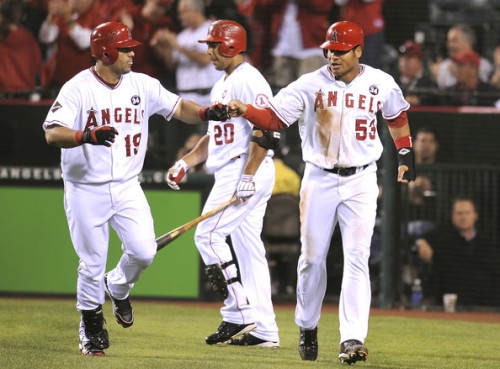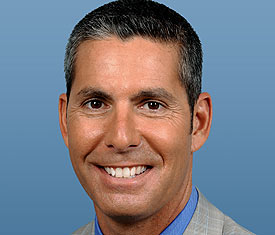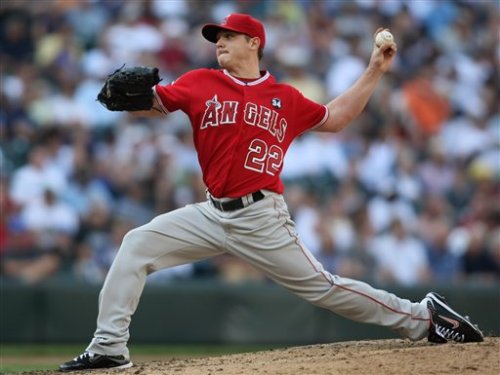I’ve been all for having each team being represented in the All-Star Game… until today.
Today just made me realize that the under-qualified and under-represented took priority over the clearly qualified, and that is an absolute shame.
You know the story by now.
Angels’ ace Jered Weaver was left off the All-Star roster despite his numbers giving him a fantastic shot of reaching his 1st All-Star Game… let alone with it being in his home stadium.
It’s not like Weaver was “on the fence” to begin with.
He should be in the game.
Here are Jered Weaver’s statistics on the 2010 season:
8-3 record/2.82 ERA/124 K/26 BB/1.06 WHIP/.217 BAA
He ranks 1st in the American League in strikeouts, 3rd in WHIP (Walks + Hits / Innings Pitched), and holds the AL’s 6th best ERA.
Looking at his 17 starts on the season, in his 8 wins, he has been great in each, going more than 6 innings in each win (going 7 or more in 5 of those 8 wins), and in his 3 losses, you could say he had a better chance to lose rather than win on that given day (allowed, 4, 4, and 6 runs in those respective losing decisions).
But looking at the games where he was given a No Decision shows that Weaver’s 8-3 record doesn’t do his half-season performance total justice.
In Weaver’s 6 No Decisions, he had given up 2 runs or less in 5 of those 6 starts, outings by Jered that definitely should have given him a W compared to a ND.
His record could potentially be 13-3 at this point if all happened to go right on those days (it usually doesn’t work out that way but let’s just roll with it).
So which starting pitchers did get in to the All-Star Game? Let’s run down the list here.
– Clay Buchholz, Boston Red Sox. Deserving. The kid’s been fantastic this year. 10-4 record with the 3rd lowest ERA in the American League at 2.45, Buchholz no doubt deserves his 1st All-Star nod, but as we’ll get into later, the key to Weaver’s potential last chance of an All-Star game appearance lies in the hamstring of Clay Buchholz.
– Trevor Cahill, Oakland Athletics. Deserving. Oakland was one of 3 American League teams to have just 1 player represent their team, but Cahill represents the A’s well. The 3rd youngest player on the American League roster (the 2 youngest are Rangers shortstop Elvis Andrus [21] and Rangers closer Neftali Feliz[22], the 22-year-old Cahill got a deserving selection into the All-Star Game and should have been in regardless of whether or not each team had to be represented. 8-2 record, sub-2.75 ERA, the kid is where he belongs, on the roster for the first time in his incredibly young career.
– Phil Hughes, New York Yankees. Deserving. Hughes has faltered of late, allowing 19 of his 40 earned runs on the season in his last 4 starts alone, so it’s safe to say he stumbled into the All-Star Game roster. He stands at 10-2 with a less than impressive 3.83 ERA for an All-Star, but before the string of ERA-inflated outings, he was 8-1 with a 2.71 ERA, a little more telling of how his season had been going. Still a deserving 1st-time bid.
– Cliff Lee, Seattle Mariners. Deserving. He joined Ichiro as the other Mariner to be selected to the All-Star Game, and he’s been downright filthy since the start. Lee’s got the lowest ERA in the AL (2.34) as well as the lowest WHIP ratio (0.95!). If that wasn’t enough, Cliff Lee has been as accurate and as tough to hit as any pitcher out there. His strikeout-to-walk ratio is an otherworldly 14.83… that’s more than 3 times as good as the American League’s next-best qualified starting pitcher… Jered Weaver. Lee is up there as one of the league’s top arms, he was an All-Star shoe-in.
– Jon Lester, Boston Red Sox. Deserving. Lester’s 2010 season got off on the wrong foot. After his first 3 starts, he had an 0-2 record with an ERA of 8.44 (15 earned runs in 16 innings pitched). Since that atrocious start, Lester has won 10 of 11 decisions, and cut his ERA down by more than 5 1/2 runs to be at 2.76. A top-5 American League pitcher in ERA, WHIP, strikeouts, and innings pitched, Lester deserved his 1st All-Star appearance.
– David Price, Tampa Bay Rays. Deserving. David Price has been living up to his #1 overall draft pick potential in 2010. He currently has an AL-leading 11 wins, and the 2nd best ERA (2.42), there’s no way that someone should have gotten this All-Star spot over Price. He has been outstanding this year and is completely deserving of heading to the Mid-Summer Classic. Oddly enough, of the American League’s 8 starting pitchers, Price is one of 6 to be making their first career All-Star appearances.
– CC Sabathia, New York Yankees. Deserving. Joe Girardi made this an easy choice, but let’s not have that take away from what Sabathia has meant to the Yankees. The guy’s been a straight horse for Girardi’s bunch. He’s thrown the 2nd most innings pitched in the AL and is tied for the 2nd most wins with 10, as well as having the AL’s 7th best WHIP mark of 1.13. A worthy 4th All-Star selection for the hefty lefty.
Which brings us to our final All-Star starter…
– Fausto Carmona, right-handed pitcher of the Cleveland Indians making his first career All-Star appearance.
The only player on the roster from the Cleveland Indians (it should have been outfielder Shin-Soo Choo to be the Indians representative if anybody). So this was really the “have-to-put-somebody-in” pick for the AL.
On the season, Carmona’s 7-7 with a 3.69 ERA, and a 1.29 WHIP ratio. Carmona’s 7 wins is the lowest of the AL All-Star starters. His 7 losses is the most of the AL All-Star starters (the next lowest is 4). His 3.69 ERA is the 2nd worst of the AL All-Star starting pitchers, and by a slim margin.
Let’s compare Carmona’s 2010 numbers to Weaver’s 2010 numbers side-by-side:
Weaver- 8-3 record/2.82 ERA/124 K/26 BB/1.06 WHIP/.217 BAA
Carmona- 7-7 record/3.69 ERA/57 K/39 BB/1.29 WHIP/.250 BAA
Who has more wins? – Weaver
Who has fewer losses? – Weaver
Who has a better ERA? – Weaver
Who has been tougher against hitters? – Weaver
Who is clearly the more deserving pitcher here? – Weaver
In conclusion, Weaver has won more, lost less, held a lower ERA by close to a full run, struck out over 60 more batters, walked 13 fewer batters, allowed fewer baserunners, and allowed allowed fewer hits to opposing batters.
No-brainer, right?
Wrong, buddy.
Because of the “everybody gets represented” rule, Carmona, the clearly inferior pitcher in this comparison gets the All-Star nod because his team had nobody else to put in. Let’s be clear here, the Indians are not what you’d call an above-average baseball team (32 wins is tied for the 3rd lowest in all of baseball). The Indians would need way more than Rick “Wild Thing” Vaughn, Willie Mays Hayes, and Pedro Cerrano to even be considered a middle of the pack ballclub (but shipping off Cy Young winners CC Sabathia and Cliff Lee as well as All-Star catcher Victor Martinez in the past few years kind of put them in this spot).
This representation rule lets fans know that it’s about quantity over quality.
Statistically speaking, was Fausto Carmona more deserving than Jered Weaver? No.
But representatively, he was “more deserving” because the Indians had no one from their team selected while the Angels already had Torii Hunter penciled in as a reserve.
It’s ridiculous to me, but hey, it is what it is. Me writing this won’t tell Joe Girardi to get up and erase Fausto’s name out and throw that lanky kid Weaver’s name in there instead.
So as it stands, Jered Weaver is left out of the All-Star Game… for now.
But back on June 26th, BoSox’ All-Star right-hander Clay Buchholz injured his hammy while running the bases, and this injury might just set him on the Disabled List, potentially paving the way for Jered Weaver to be his All-Star replacement. If this indeed happens (it appears likely Buchholz will miss his next start), don’t sleep on Felix Hernandez, though. His 6-5 record doesn’t quite do him justice, but when you look at the numbers, the scales tip in Jered’s favor if you had to pick between him or King Felix for the spot.
Update: Andy Pettitte selected through player voting to replace Buchholz
The “every team needs to be represented” rule isn’t just negatively affecting the American League (I could also get into the snubs of deserving guys like Kevin Youkilis, Michael Young and Andy Pettitte, Alex Rios even?), it’s just as prevalent if not even more so in the National League.
Let’s first look at the case of Cincinnati Reds’ first basemen Joey Votto (a first-half National League MVP candidate, I might add). Despite being in the top-5 in the National League in batting average (.312), home runs (19), RBI (57), runs scored (53), on-base percentage (.412), slugging percentage (.572), and OPS (.984)… Votto is still not on the team. It’s tough to make the squad when you’re competing against guys like Albert Pujols, Ryan Howard and Adrian Gonzalez (all who made the team), and it wouldn’t make much sense to carry 4 first basemen, but in this case, it would have.
You’re telling me outfielder Michael Bourn of the Astros, hitting a not-so-eye-popping .260 with 20 RBI is more deserving than Joey Votto because he didn’t have another player on his team worthy of being an All-Star? I know they don’t play the same position and hence couldn’t fill the same roster spot but still, come on, really?
Let’s also take a look at Mat Latos, the talented 22-year-old starter for the San Diego Padres. The youngster’s been unbelievable for the Pads this year, putting together a 9-4 record with a 2.62 ERA and a league-best 0.96 WHIP ratio. The guy’s had 5 outings of 7 or more innings without allowing a run this year and has been instrumental in vaulting the Padres to the National League’s best record as it currently stands.
He didn’t make it either. However, Brewers’ hurler and All-Star-elect Yovani Gallardo injured an oblique muscle… which may just lead to a more than deserving All-Star nomination for the youngster Latos (a similar case could easily be made for the Mets’ Mike Pelfrey as well).
The biggest snub in my mind is Miguel Olivo, catcher for the Colorado Rockies. How in God’s beautiful green earth he isn’t the starting catcher for the NL is beyond me. Fan voting put Yadier Molina (really? … the guy isn’t even hitting .230!) in for his 2nd career All-Star appearance (another part of the All-Star game that needs to be altered somehow is the usage of fan voting… read on to see my solution). And the reserve catcher nomination went to the Braves’ Brian McCann. I can deal with McCann being an All-Star, but not Molina. Here’s why.
Here are the statistics of those three backstops: (bold indicates the best mark among the 3 players)
Molina- .229 avg./3 HR/31 RBI/12 XBH/16 R/.309 OBP/.302 SLG/.611 OPS
McCann- .265 avg./10 HR/34 RBI/23 XBH/38 R/.381 OBP/.449 SLG/.830 OPS
Olivo- .307 avg./11 HR/39 RBI/22 XBH/37 R/.363 OBP/.538 SLG/.901 OPS
It’s safe to say that this year, Yadier Molina isn’t quite in McCann or Olivo’s class. But yet, there he is. Starting in the All-Star game despite hitting 78 points lower than a guy who isn’t even on the squad. Of those 8 statistical categories, Olivo is best in 5 of them amongst the three listed catchers, and loses 2 of those categories by only 1 extra base hit and 1 run scored.
Fact: there will always be snubs. Somehow, someway there will always be at least 1 All-Star snub.
Problem: fan voting, while necessary to give baseball fans a feeling of importance that they can potentially select the starting lineups all by themselves, is not implemented in the best possible way.
Quick and easy two-part amendment/solution to avoid roster snubs and to just plain “get it right”:
#1.) First, get rid of the “each team gets represented rule.” If you’re deserving, you’re in. If you’re the best player on a bad team and you don’t meet the qualifications for an All-Star bid, too bad. Some form of equal representation will not unfairly help you get in over someone else whose team already has somebody into the All-Star Game.
Case in point: if you’re good enough, you’re in. Doesn’t matter if you already have a player from your team on the roster or not, if your season’s numbers should earn you an All-Star appearance, you’ll be rewarded for your performance fairly.
#2.) Second, to select All-Star starters, you take a little bit of both in regards to the current system. What I mean by this is that you effectively combine how All-Star starters are selected (fan voting) and how reserve All-Stars can be appointed (All-Star manager’s selection). What you do is you allow fan voting to take place, but once voting ends, you take the top-3 vote-getters at each position, and the manager will choose the most deserving of those 3 to be the starter at that particular position. You still allow fans to have a say in who could start in the All-Star Game, and with the manager’s approval, you just about eliminate the chance that an oft-injured fan-favorite who has spent most of the season on the DL will start in the All-Star Game, leading to at least 1 fewer snub if that were the case.
Case in point: who the All-Star team’s manager views as the best player of the fan-voted top-3 at each position will be appointed a starting job in the All-Star game. It keeps the fan in a position of power without completely stripping fans of their individual vote’s significance, and by the manager selecting 1 of the top-3 vote-getting players at each position, I feel that this could be a reasonable and realistic solution for the All-Star Game and its rosters to be almost as right as they could possibly be
Enough of hearing about the snubs, it’s time for the All-Star game to get a face-lift.
Heck, if the All-Star Game can change it’s rules to where the outcome of the game decides something unbelievably important (who gets home field advantage in the World Series), why can’t it change its rules to where the Mid-Summer Classic rewards baseball’s best players, regardless of team, instead of rewarding a decent player on a team that can’t seem to rack up more than 8 wins in a month over a guy who is clearly deserving but already has his club represented in the game?
We all know that something has to change. There’s nothing worse than seeing a guy you pull for being snubbed in favor of some middle-of-the-road guy on a last place team… the sentiment Angel fans are currently feeling.
It’s just not right.
And it’s time that that changed.
If you have any resolutions that you’d like to see implemented into the All-Star Game, feel free to comment or let me hear it on Twitter by replying to @TheHalosBlog!





